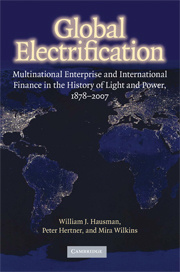 Global Electrification
Global Electrification Book contents
- Frontmatter
- Contents
- Tables and Illustrations
- Series Editors' Preface
- Preface
- Acknowledgments
- Authors and Contributors
- PART I CONCEPTS
- PART II CHANGES
- 3 Every City, 1880–1914
- 4 War, the First Nationalization, Restructuring, and Renewal, 1914–1929
- 5 Basic Infrastructure, 1929–1945
- PART III CONCLUSIONS
- Appendix A: Abbreviations, Acronyms, Company Names, and Variations on Company Names
- Appendix B: Notes to Table 1.4 Foreign Ownership of Electric Utilities, Four Periods
- Notes
- Select Bibliography
- Index
5 - Basic Infrastructure, 1929–1945
Published online by Cambridge University Press: 26 July 2009
- Frontmatter
- Contents
- Tables and Illustrations
- Series Editors' Preface
- Preface
- Acknowledgments
- Authors and Contributors
- PART I CONCEPTS
- PART II CHANGES
- 3 Every City, 1880–1914
- 4 War, the First Nationalization, Restructuring, and Renewal, 1914–1929
- 5 Basic Infrastructure, 1929–1945
- PART III CONCLUSIONS
- Appendix A: Abbreviations, Acronyms, Company Names, and Variations on Company Names
- Appendix B: Notes to Table 1.4 Foreign Ownership of Electric Utilities, Four Periods
- Notes
- Select Bibliography
- Index
Summary
On October 24, 1929, and in the weeks following, the stock market crashed in the United States. There were multiple problems in the workings of the international economy before the Wall Street crisis. Given America's pivotal role in the world economy, its aftermath meant cascading, albeit uneven, consequences around the globe. Initially, however, it did not appear that the operations and growth of electric utilities would be seriously affected. People cut back on their electricity consumption very little. The expansion of electrification in the 1920s had created a global demand for more access to electric power and added supplies. There was a demonstration effect: As the average consumer became aware of the comforts that came with electricity and new efficiencies brought down its price, demand rose on a worldwide basis. To be sure, electric utilities would incur losses in revenues with the downturn, but contemporaries assumed that this would be merely temporary and that electric utility companies were fundamentally sound. Thus, when the prices of utility securities fell in 1930, along with those of other stocks and bonds, knowledgeable foreign investors saw this as an opportunity to buy American public utility securities on the cheap. The important Swiss holding company Bank für Elektrische Unternehmungen (Elektrobank), Zurich, for example, made its very first U.S. investments in 1930. In that year and even in early 1931, respectively, J. P. Morgan & Co. had no problem arranging to float loans for Toho Electric Power Company and Taiwan Electric Power Company.
- Type
- Chapter
- Information
- Global ElectrificationMultinational Enterprise and International Finance in the History of Light and Power, 1878–2007, pp. 190 - 230Publisher: Cambridge University PressPrint publication year: 2008
